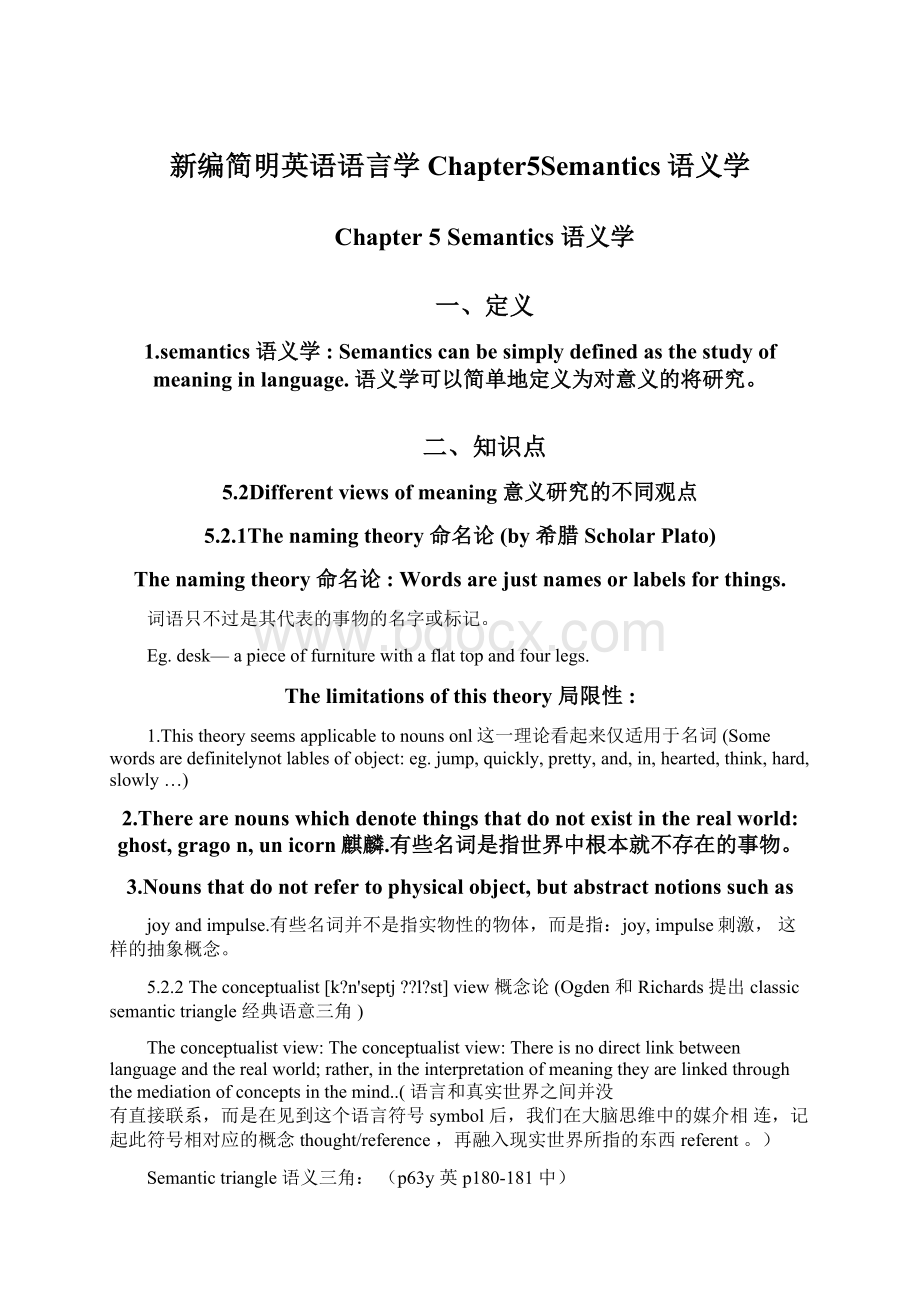新编简明英语语言学Chapter5Semantics语义学.docx
《新编简明英语语言学Chapter5Semantics语义学.docx》由会员分享,可在线阅读,更多相关《新编简明英语语言学Chapter5Semantics语义学.docx(8页珍藏版)》请在冰豆网上搜索。

新编简明英语语言学Chapter5Semantics语义学
Chapter5Semantics语义学
一、定义
1.semantics语义学:
Semanticscanbesimplydefinedasthestudyofmeaninginlanguage.语义学可以简单地定义为对意义的将研究。
二、知识点
5.2Differentviewsofmeaning意义研究的不同观点
5.2.1Thenamingtheory命名论(by希腊ScholarPlato)
Thenamingtheory命名论:
Wordsarejustnamesorlabelsforthings.
词语只不过是其代表的事物的名字或标记。
Eg.desk—apieceoffurniturewithaflattopandfourlegs.
Thelimitationsofthistheory局限性:
1.Thistheoryseemsapplicabletonounsonl这一理论看起来仅适用于名词(Somewordsaredefinitelynotlablesofobject:
eg.jump,quickly,pretty,and,in,hearted,think,hard,slowly…)
2.Therearenounswhichdenotethingsthatdonotexistintherealworld:
ghost,gragon,unicorn麒麟.有些名词是指世界中根本就不存在的事物。
3.Nounsthatdonotrefertophysicalobject,butabstractnotionssuchas
joyandimpulse.有些名词并不是指实物性的物体,而是指:
joy,impulse刺激,这样的抽象概念。
5.2.2Theconceptualist[k?
n'septj?
?
l?
st]view概念论(Ogden和Richards提出classicsemantictriangle经典语意三角)
Theconceptualistview:
Theconceptualistview:
Thereisnodirectlinkbetweenlanguageandtherealworld;rather,intheinterpretationofmeaningtheyarelinkedthroughthemediationofconceptsinthemind..(语言和真实世界之间并没
有直接联系,而是在见到这个语言符号symbol后,我们在大脑思维中的媒介相连,记起此符号相对应的概念thought/reference,再融入现实世界所指的东西referent。
)
Semantictriangle语义三角:
(p63y英p180-181中)
(直线表示两者之间有直接联系,虚线表示两者之间无直接联系。
)
这一理论的主要缺点是人们并不清楚符号与概念或意念之间到底有什么精确的联系。
有的学者认为这种联系是一种心理活动过程.但问题是人们在遇到一个命名标记时,事实上,人们并不需要看到它们在脑海里形成的意象。
5.2.3Contextualism语境论观点代表人是JohnFirth,但Bloomfield阐述更有说服力
Thecontextualistviewofmeaningisbasedonthepresumptionthatonecanderivemeaningfromorreducemeaningtoobservablecontexts.意义的语境论基于这样一个假设:
人们可以从可观察的语境中推出意义,或者将意义还原至可观察的语境。
(语境论认为语言的意义来自语境,取决于语境。
)
Twokindsofcontextarerecognized:
1.thesituationalcontext2.thelinguisticcontext已被人们承认的语境有两种:
场景语境和语言语境。
situationalcontext场景语境:
Thesealcouldnotbefound.(海豹、印章)
Sheisatthedesk.(在桌子旁边、在读书)
Linguisticcontext语言语境:
greenhouse(温室)
greenhand(生手,没有经验的人)
greentea(绿茶)
{情景语包括时空环境,交际的参与者,当时的行为活动,环境中的相关物体等。
语言语境包括词之间的共现或搭配。
这种共现和搭配构成了这个词的语义的一部分。
例如在blackhair(黑发)和blackcoffee(不加牛奶的清咖啡)中,black词义的不同是它的搭配不同所致。
语言语境也包括一个特定话语的上下文。
}
5.2.4Behaviorism行为主义论英国Bloomfield提出,使用了Jack和Jill故事阐明Themeaningofalanguageform语言形式的定义:
asthesituationinwhichthespeakeruttersitandtheresponseitcallsforthinthehearer.言着发出该形式的场景和它在听者身上所起的反应。
(ByBloomfield1933)。
(Bloomfield以行为主义心理学为基础提出了语义的行为主义论。
Bloomfield认为语义存在于情景中,存在于说话人所说的话在听话人身上引起的反应的情景之中。
)
JillJack
Sr.sR
5.3lexicalmeaning词汇意义
5.3.1distinctionsbetweensenseandreference区分意义和指称意义和所指是词汇意义的两个侧面,彼此既有联系,又有差异。
1.Sense意义:
It'sconcernedwiththeinherentmeaningofthelinguisticform.It'tshecollectionofallthefeaturesofthelinguisticform,it'asbstractandde-contextualized.意义指的是语言形式的内在意义。
意义是词汇抽象的、内在的、独立于语境之外而存在的意义。
这种意义通常是词典编撰人员所关心的。
(例如:
"boy"在字典中被定义为"amalechild,tillpubertyoryoungmanhood."这里,
“男孩”并不指任何现实世界中具体的男孩,任何一种具有定义特征的人都可称为“男孩”。
)p66英
2.Reference指称:
Itmeanswhatalinguisticformreferstointhereal,physicalworld,itdealswiththerelationshipbetweenthelinguisticelementandthenon-linguisticworldofexperience.指称是词汇在特定的语境中所指称的具体事物。
它是关于语言与非语言的客观世界之间的关系。
(例如:
”Theboyiscrying.在这个例子中,”boy一定是有所指的,特指一个交际活动中交际者都知道的那个“男孩”。
这就是在这个特定的交际情景中“男孩”的所指。
)p66英
(1)意义(sense)相同的词在不同语境中所指reference可能会不同,例如:
Isawaboyatthegateyesterday.
Isawamanbeatingaboyinfrontofthehouse.
(2)另一种情况是词的所指意义referenee可能相同,但是意义sense却不同,例如:
morning
star(辰星)和eveningstar(昏星)意义是不同的,但是所指是相同的,都指我们子啊天空中看到的“金星”。
5.3.2majorsenserelations主要的意义关系
5.321Synonymy[s?
'n?
n?
m?
]同义现象
Synonymy同义词:
Itreferstothesamenessorclosesimilarityofmeaningorwecansaythatwordsarecloseinmeaningarecalledsynonyms['s?
n?
n?
m].同义现象指意义的相同或极为相近。
意义相近的词成为同义词。
由于历史的原因,大量的外来词borrowed(loan)words加入本族词nativewords,使得英语中富含同义词。
在任何语
境中都可以相互替代的绝对同义词十分罕见。
绝大多数同义词之间存在着语义上的微妙差异。
同义词通常分为五类:
1)Dialectalsynonyms——synonymsusedindifferentregionaldialects
[,dai?
'lekt?
l]方言同义词——用于不同地区方言的同义词。
①方言同义词是指在语义上相同或相近的词,但是用在不同的方言之中,如p67英:
BritishEnglish英式英语AmericanEnglish美式英语
Picture
Movie
ill
Sick
Engine
Motor
Post
Mail
②即使在美国英语或英国英语内部也存在方言同义词。
Eg.gril女孩在苏格兰方言中:
lass/lassie
liquor烈酒在爱尔兰方言中:
whisky
2)Stylisticsynonyms---Synonymsdifferinginstyle
文体同义词——文体上存在差异的同义词
在文体或使用正式程度上相异的同义词是文体同义词。
(更加正式、中性、非正式)例如:
start,begin,commence开始
ask,question,interrogate疑问
fear,terror,trepidation恐惧
gee-gee,horse,steed马
kid,child,offspring孩子
gratitude,thanks感谢
inquire:
,ask查询,询问
oldman,daddy,father,maleparent父亲
kickthebucket,popoff,die,passaway,decease死亡
3)Synonymsthatdifferentintheiremotiveorevaluativemeaning情感意义或评价意义相异的同义词(褒贬情感)有些同义词有着相同的所指意义,但是表达了不同的情感。
例如“small”和
“little”是同义词,但是“small”是中性词,不含有情感语义色彩,而“little”却蕴涵浓厚的情感色彩,是比较:
Poorlittleboy!
4)Collocational[,k?
l?
u'kei?
?
n]synonyms搭配同义词
有些词是同义词,但是搭配不同,如:
aflockof,apackof,aherdofaswarm
of,aschoolof
,它们搭配如下:
Aflockofsheep
一群绵羊
seeamovie
Apackofwolves
一群狼
watchamatch
Aherdofcows
一群奶牛
Aswarmofbees
一群蜜蜂
handsomeboy
Aschoolofwhales
一群鲸鱼
prettygirl
5)Semanticallydifferentsynonyms语义上存在差异的同义词
一些同义词在语义上略有差异,例如rage愤怒,fury狂怒,indignation义愤在语义上与
anger相近,但是rage暗含“情感的失控”;fury是这几个词中语义强度最强的词,暗含“情感的失控到了几乎疯狂的程度”;indignation暗含“由于道义上的原因引起的愤怒。
”
5.3.2.2Polysemy多义关系
Polysemy多义词:
Itreferstodifferentwordsmayhavethesameorsimilarmeaning,thesameonewordmayhavemorethanonemeaning.
多义现象是指同一个词有一个以上的意义。
以table为例,它的意思有:
(1)apieceoffurniture一件家具
(2)allthepeopleseatedattable所有坐在桌子边的人
(3)thefoodthatisputonatable放在桌子上的食物
(4)athinflatpieceofstone,metal,wood,etc一块扁平的石头、金属、木
(5)orderlyarrangementoffact,figures,etc事实、数据等的有序排列
(6)alevelarea,aplateau平坦的区域、高原
从历史的角度看,多义现象是词义的增长、发展或变化的结果。
5.3.2.3Homonymy[h?
'm?
n?
m?
]同音(形)异义
Homonymy同音(形)异义:
Itreferstothephenomenonthatwordshavedifferentmeaningshavethesameform,i.e,differentwordsareidenticalinsoundorspelling,orinboth.同音异义是指某些词的意义不同,但是具有相同形式的现象,即不同的词在发音或拼写上一样,或者发音和拼写都一样。
1)Homophones/'?
hm?
.f?
?
ns/同音异义:
Itreferstotwowordsareidentical完全相同insound.
e.g.rain雨/reign统治;night晚上/knight骑士;piece片/peace和平;leak泄露/leek韭菜
2)Homographs/'?
h?
.g?
f/同形异义:
Itreferstotwowordsareidenticalinform.
e.g.bowv.弯腰、鞠躬/bown.弓;tearv.流泪、撕/tearn.眼泪;
leadv.导致/leadn.领导、铅(制品)
3)Completelyhomonymy[h?
'm?
n?
m?
]完全同音同形异义:
whentwowordsareidenticalinbothspellingandsound.
e.g.fastadj.快的、牢固的/fastv.禁食、斋戒;scalen铁屑、标志/scalev.测量、把..过秤ball(英语本族语):
球/ball(法语):
可跳舞的正式社会活动、宴会
5.324Hyponymy[ha?
'p?
n?
m?
]:
下义关系、上下位关系(词与词之间的)
Hyponymy上下义关系:
Itreferstothesenserelationbetweenamoregeneral,moreinclusivewordandamorespecificword.Thewordwhichismoregeneralinmeaningiscalledsuperordinate,andthemorespecificwordsarecalleditshyponyms.下义关系是指一个更广义、更具有包容性的词与一个更具体的词之间的意义关系。
意义更广泛的词叫上坐标,更为具体的词称为下义词。
Hyponymyisarelationofinclusion;intermsofmeaning,thesuperordinateincludesallitshyonyms.下义关系是一个包含关系;上坐标词在意义上包括所有的下义词:
e.g.p70英p188中
5.3.2.5Antonymy[?
n't?
nimi]反义现象
Antonymy反义词:
It'sthetermusedforoppositenessofmeaningondifferentdimension.意义上的对立的词叫反义词。
Antonymy分类:
(1)Gradableantonyms分级反义词(amatterofdegree程度有级差)
e.g.Old—middle-aged—young;hot-warm-cold
(2)Complementaryantonyms互补反义词(amatterofdegreebetween非彼即此,不存在第三者可能性)
e.g.alive—dead;male—female;boy—girl
innocent无辜的一guilty有罪的;odd奇数一even偶数;hit击中一miss错过;
(3)Relationalopposites关系反义词(中间可以加成分,如上、中、下。
两者之间关系颠倒)
e.g.father—son;teacher—pupil;doctor—patient;buy—sell;above—below
rent租用一let出租;host主人一guest客人;before—after;parent—child
bigger—smaller;give—receive
5.4senserelationsbetweensentences句子之间的意义关系
1)XissynonymouswithY.(X与Y同义)
2)XisinconsistentwithY.(X与Y不一致)
3)Xentails[?
n'te?
i]Y.(YisanentailmentofX)X蕴含Y(Y是X的一个含义)
4)Xpresupposes[pri?
s?
'p?
?
z]Y.(YisaprerequisiteofX)X预设Y(Y是X的先决条件)
5)Xisacontradiction[k?
ntr?
'd?
k?
(?
)n](X是一个矛盾)
6)Xissemanticallyanomalous[?
'n?
m(?
)l?
s](X语义反常)
5.5Analysisofmeaning意义的分析
5.5.1Componentialanalysis—awaytoanalyzelexicalmeaning成份分析法——对词汇成分的分析
成分分析法ComponentialAnalysis分析词汇抽象意义:
It'sawayproposedbythe
structuralsemanticiststoanalyzewordmeaning.成分分析是由结构语义学家提出的分析词
义的方法。
(Thisapproachisbaseduponthebeliefthatmeaningofawordcanbedissectedintomeaningcomponents,calledsemanticfeatures.这个理论基于这样一个信念:
一个词的意义能被分解成被称为语义特征的意义成分。
)
Plusandminimumssignsareusedtoindicatewhetheracertainsemanticfeatureispresentorabsent,thesefeaturesymbolsareusuallywrittenincapitalizedletters.Oneadvantageofcomponentialanalysisisthatbyspecifyingthesemanticfeaturesofcertainwords,itwillbepossibletoshowhowthesewordsarerelatedinmeaning.加减号用来表示某一语义特征在一个词义中是存在或缺省,这些特征用大写字母来写。
5.5.2PredicationAnalysis—awaytoanalyzesentencemeaning述谓结构分析——分析句子意义的一种方法(由BritishLinguistG.Leech提出)
在分析句子的意义之前,有两点应该明确:
1)一个句子的意义并不是它所有组成部分意义的总和。
一个句子的意义不能通过把组成它的
所有单词的意义的相加来得出。
2)句子的意义包含两个方面:
语法意义(grammaticalmeaning)和语义(semanticmeaning)。
一个句子的语法意义是指它的语法性。
一个句子的语义是否可接受受选择性限制规则的支配。
语法性受语言的语法规则的支配。
选择性限制规则是对词的结合或搭配进行限制的规则,以确保语义的可接受性。
符合语法的句子并不一定就是语义可接受的句子。
例如:
*Thebrownconceptjumpssympathetically.
述谓分析predicationanalysis是由BritishlinguistG.Leech提出的一种分析句子语义的手段。
句子由主语、谓语构成,是语法分析的基本单位。
述谓predicationAnargumentisalogicalparticipantinapredication,largelyidenticalwiththenominalelementsinasentence,apredicateissomethingsaidaboutanargumentoritstatesthelogicalrelationlinkingtheargumentsinasentence.述谓是句子基本单位,是对句子的抽象化,